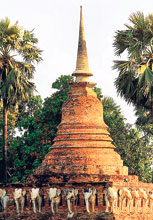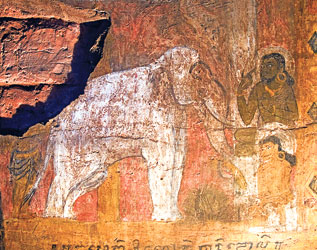It was on the Poson full moon day in June 306 B.C. (i.e. 237 years after the demise of the Buddha), that Arhat Mahinda formally introduced Buddhism including the Tripitaka to Sri Lanka. According to the Mahavamsa, Asoka sent Arhat Mahinda to Sri Lanka, and other missionaries to several other regions including "Suvannabhumi" (present Southeast Asia). The edicts of Asoka though, do not mention Suvannabhumi. Later Upasika Bodhisiri of Nagarjunakonda mentions in a 3rd century inscription that Sinhalese monks had converted Kashmir, Gandhara in Afghanistan, China, Kirata, Tosali, Aparanta, Bengal, Vanavasi, Yavana, and Tamil regions.
The Sinhalese Prince Aryadeva becoming Nagarjuna's chief disciple was the co-founder of Mahayana (Madhyamika) philosophy in the period 1st - 2nd centuries C.E. Sinhala Bhikkhunis went to China in the 5th century and initiated the Bhikkhuni Sasana there. Several Bhikkhus from Sri Lanka went to China, the most important being Amogavajra who taking 500 Tantric texts from Abhayagiri became an adviser to the Chinese Emperor and established sects in Korea and Japan. In central Java, Indonesia an "Abhayagiri Vihara of Sinhala ascetics" was established in the 7th century, and recently it has been proposed that Borobudur itself was designed by Sinhalese Bhikkhus from Abhayagiri. In the 11th century, a Sinhala Bhikkhuni and a Sinhala Bhikkhu helped in formulating the Tibetan Tripitaka. The record is impressive.
But the major impact of Sinhalese culture was on Southeast Asia - on Myanmar, Thailand, Cambodia, Laos, southern Vietnam and the Yunnan province of China. Sinhala Bhikkhus taught Pali, the language of the Tripitaka as well as Theravada Buddhist culture and brought in Sinhala forms of sculpture, architecture, literature and painting to the region. This article is on this Southeast Asian connection - albeit a brief summary.
Myanmar
After the Chola invasion, the Buddhist order was re-established from Ramanna country (Lower Myanmar), very probably from Sinhala monks who had fled the Chola brutality, and were then living there. From the beginning of the founding of Myanmar, Sinhala Bhikkhus taught the Tripitaka and the Pali language, incidentally through the Sinhala script. Rajakumar, the son of King Kyanzitta (1084-1113) studied the Tripitaka and the Mahavamsa as is evident from the paintings of the Mahavamsa episodes on the walls of the Myinkaba Kubyauk-gyi. Included are the following scenes: the Buddha's visits to Sri Lanka, Emperor Asoka and King Devanampiyatissa, Devanampiyatissa's meeting with Thera Mahinda, sending of the Bodhi tree with Sanghamitta etc.
 |
| Bell stupa surrounded by elephants,
14th Century in Thailand |
Myanmar Bhikkhus later composed their own chronicles directly modelled after the Mahavamsa - such as their Mahasammatavamsa, Rajavamsa and Sasanavamsa.
During the time of Parakramabahu I, a delegation of Bhikkhus headed by the Myanmar Sangharaja visited Sri Lanka on pilgrimage in 1170 accompanied by a samanera Chapata, who received upasampada here. On his return to Myanmar and with the patronage of King Narapatisithu, he set up a new sect, "Sihala (Sinhalese) Sangha" which became dominant. In 1331, a Sinhala Mahathera, Udumbara Mahasami from Udumbaragiri (present Dimbulagala) had arrived in Bago (Pegu) in Lower Myanmar.
The king impressed by the monk conferred on him the honorific title 'Udumbarapuppha Mahasami'. His fame attracted monks from Sukhothai in Thailand to go to Bago and receive upasampada.
Dhammazedi (1472-92), King of Bago, having received education in one of the many Sihala Sangha monasteries in Ava, chose 22 senior monks to go to Sri Lanka in 1476 and receive upasampada under the leadership of Mahathera Vidagama.
After their return, the King consecrated for ecclesiastical acts an ordination hall (sima) known as the Kalyani sima because these Bhikkhus had received their ordination on our Kalani River. The entire order of Myanmar Bhikkhus - a total of 15,666 - was now re-ordained on the new Sinhala template.
Thailand
In Thailand, Sinhalese Buddhism made major inroads first in the peninsula in South Thailand - Nakhon Si Thammarat (NST) whose monks had gone to Sri Lanka, studied and received upasampada. In the 13th century, the much revered Sihinga (Sinhala) Buddha image was sent to King Rama Khamheng of Sukhothai, the first kingdom of Thailand by Parakramabahu II of Dambadeniya. Wars were later fought by Thai rulers to own this Sinhalese image. Another 'Sinhala origin' image, the Emerald Buddha located in the Royal Palace is the national palladium of Thailand.
King Lothai (1317-1347), the son of Rama Khamheng, too became a great admirer of Sinhala Bhikkhus. He requested Udumbara Mahasami, then resident in lower Myanmar to send a monk to perform upasampada. Udumbara Mahasami's disciple established the Sihala (Sinhala) Sangha sect in Sukhothai, Thailand's first capital. Subsequently Udumbara Mahasami's disciples established the Sinhala Sangha in Chiangmai, Lamphun and in Sajjanalaya - all in Northern Thailand.
Buddha relics brought from Sri Lanka were enshrined all over Thailand in Sri Lankan style ceti (chaitya). In the 14th century, branches of the sacred Bodhi tree from Anuradhapura were also planted with great veneration by Thai royalty. An inscription of King Luthai (1347-1368) records that his artisans made several copies of the Buddha's Footprint from Sri Lanka. A mountain in Thailand was given the name Samantakuta. Luthai also being a great patron of the Sinhala Sangha received with major celebrations, the Sangharaja Medhankara from Sri Lanka and a group of Sinhala sect monks. The King offered this Sinhalese Sangharaja a specially built monastery. The King studied under this Sinhala monk, and at the end of the vassa season, received temporary ordination from him.
 |
Sri Sraddha (Si Satha), a nephew of king Rama Khamheng visited Sri Lanka in the 14th century and stayed for ten years at Gampola and Mahiyangana. Thai inscriptions record his visiting Samantakuta and repairing the Ruwan Weli Seya, Mahavihara and the Mahiyangana Cetiya. He took back a Kesadhatu and a Givadhatu to Sukhothai. He also took with him, a group of Sinhalese craftsmen from Gampola, settling them in five villages in Sukhothai to redesign the city. He now built over a thousand cetis, planted 300 Srimahabodhi shoots from Anuradhapura and founded a Buddha Footprint. His Sinhalese craftsmen changed features on Sukhothai's main Temple Mahathat to fit into the designs at our Lankatilake temple. The very nature of the premier city Sukhothai's religious and architectural landscape was changed.
The major architectural change was the large bell-shaped stupas with their standing elephants drawn from by our tradition. The many bell shaped stupas still seen in Sukhothai and later in the next Thai capital Ayutthaya were all modelled on these Sinhalese templates.
Wat Sihalaram (Sinhala Aramaya) in Chiang Mai with its Bodhi branch from Sri Lanka became the first centre of Pali studies in Thailand. The Bodhi tree stands up to now. A general named Sihalagotta ["Sinhala gothra", so probably a Sinhalese], by the order of the king, rebuilt Rajakuta ceti in Chiang Mai, and deposited a sacred relic, from Sri Lanka.
From the 16th century, Sri Lankan Sangha had declined due to Portuguese destruction. At the request of our King Kirti Sri Rajasinghe, King Boromkot of Thailand sent in 1753 a mission of Thai monks. This began our Buddhist revival.
Cambodia
The Hindu/Mahayana kingdom of 12th century Cambodia of Angkor Wat fame was turning towards Sinhalese Buddhism during the same period as witnessed by a Polonnaruwa style small stupa at the centre of the Angkor Thom complex and by the Sinhalese inspired Buddhapada at Angkor Wat. After King Ponhea Yat established Phnom Penh as the capital in 1432, he built there five wats (vihara).
All these wats had Sinhalese connections. Wat Lanka was then the principal library in the country where Sinhalese monks taught the Tripitaka.
Laos
The recorded history of Laos begins with its founding in 1353 by Prince Fa Ngum from the Lao region.
Fa Ngum's Queen, a fervent Buddhist got her husband to introduce Buddhism. Her father sent a delegation headed by three Sinhalese monks and his proudest possession, the Buddha image Prabang with "miraculous powers" which had been gifted to him by a Sinhalese king. This image became the national Palladium of the country, and its capital was renamed after it as Luang Prabang. King Fa Ngum conferred the Sinhalese monks with the highest honorific titles designating them chief monks of the two major monasteries.
A monastic complex was established with a Bodhi tree from a sprout of the Anuradhapura Bodhi tree and the vihara was known as Vat Po (Bo) Lanka. The chief Sinhalese monk Maha Tep Lanka became Fa Ngum's advisor, as well as the Sangharaja. By the end of Fa Ngum's reign, the city of Luang Prabang became known as one of the most important centres of Buddhism in the region.
Conclusion
Thus from the 11th century to the 15th century, Sinhalese religious and cultural influence impacted on Myanmar, Thailand, Cambodia and Laos. From there, it spread to southern Vietnam and the Yunnan province of China. In turn, Sri Lanka received upasampada both from Myanmar and Thailand. The relationship between Sri Lanka and these countries has been mutually beneficial. Sambuddhattva Jayanthi commemoration will further strengthen these ties. |



